From the outside, Joshua Tree, California doesn’t look like much more than a highway cutting through the desert. But its remoteness, proximity to the Joshua Tree National Park, and mystical lore makes it a lightning rod for subcultures. Once called “the art world’s Palm Springs” for its tendency to attract mid and late-career artists seeking serenity, art world tentacles brush up against meth kitchens and rock climbers, peyote tourism, mystic gurus and “sound baths”. The town used to be home to Native Americans, then prospectors, and currently, a military training base (rumored to hold a fake Afghani village populated by actors). Somewhere in town also lives Whitney Biennial artist Alma Allen, Andrea Zittel, and possibly Jack Pierson. You get the sense that feeling like nobody’s looking frees people up to do whatever they want; over the years, the area has cultivated a lot of strange and bold projects. Among them are Noah Purifoy’s Outdoor Art Museum, the Oasis of Mara, and the Hi-Desert Test Sites.
Noah Purifoy’s Outdoor Art Museum
Noah Purifoy’s Outdoor Art Museum, built between 1989 and 2004, is example of creative ambition run wild. Kind of like a mini golf course from hell, the area is covered with nightmarish walk-in junk assemblage of political stages and Civil Rights-era signs, with stations titles like “The Gallows,” “Adrian’s Theater” and “Asylum.” The whole village is built with sun-bleached recycled consumer products– tires, umbrellas, mannequins, and fake legs cut off above the knee.
Purifoy is best known for sculptures Watts Riot and 66 Signs of Neon, a 3-ton sculpture made from burned debris from the Watts Riot, the explosive six-day Civil Rights riot in LA. A social worker, Cal Arts grad, and director of the Watts Art Center, he was part of an LA scene with collaborators like David Hammons, John Outterbridge and Senga Nengudi (all were part of Now Dig This!). While his raw approach to junk assemblage is now understood to have made a major impact on his peers, Purifoy’s work is remembered by Brockman Gallery Founder and Director Dale Davis as “controversial, not well understood but interesting.” The Outdoor Museum was made here in the last fifteen years of his life.
“White/Colored” gives you a pretty good idea of what you’re in for. It’s a segregation-era water fountain station, but with a raised toilet under the “Colored” sign.
Toilets come up often in the Outdoor Art Museum, signalling both political and social attitudes. Similarly, “Voting Booth” is a row of cut-off legs in toilet stalls. My personal favorite is “The White House”, a beautiful white toilet tower, ornamented with spires and bowling balls; it does the tough maneuver of mixing a burning political MO with surface appeal. Toilets have never looked so elegant.
One can guess that Purifoy had similar attitudes toward the art establishment as white politics; “The Gallery”– kind of a small airplane hangar made of corrugated metal– is the only structure that’s closed to the public, with a deadbolt. Other art world references can be found in “Ode to Frank Gehry” (what looks like a white, curvacious lunar lander) and “Earth Piece” (a bridge over a trench, filled with twisted metal rods).
The political messages can be over-the-top to the point of hyperbole, but they’re balanced out with raw brutalism. Both ends of the spectrum are represented here in a 1950s political campaign stage, attended by rows of empty seats and fortified by a wall of spikes, legs, and umbrellas. You have the simultaneous impulse to laugh and to be very quiet. A similar hush fell over the group when we walked past “Gallows”, a pristine, whitewashed gallows. The law of Purifoy’s time might have been dumped, but attitudes fester like an old smelly manequin leg.
The Oasis of Mara
It’s just one spot that makes Joshua Tree feel like the edge of American capitalism; about fifteen minutes down the road, you’ll find The Oasis of Mara, a dried-up oasis which Native Americans had been using for at least 11,000 years. The oasis was sucked dry by miners and settlers within about 70 years. The National Park Service neglects to mention this last detail on its website, and, misleadingly, a google images search for the Oasis pulls up photos of a lake.
Instead, you walk along a loop trail with plaques which describe the lush vegetation of yesteryear. For example, “THE OLD WELL”: “At one time the well was 16 feet deep and held 600 gallons…” Others describe Native American villages which were even able to irrigate the oasis for a five-acre garden. Now the Park Service waters the trees to keep them alive.
“The days when the oasis existed in a pristine condition are long gone,” reads the final sign. “With all the human alteration there is no going back to the way it might have been.” Oh well. The rest of the park is in good shape.
High Desert Test Sites
On our last day, I decided to stop through Andrea Zittel’s High Desert Test Sites, a series of parcels with hard-to-find artworks on them, and supported by grants from the Warhol Foundation as recently as 2013/14. I debated whether or not to write about this, since there’s nothing to do there, but decided to do future visitors a favor: Check ahead.
The headquarters is open Thursday-Friday, and there’s no phone number on the website. But the site has driving directions to each plot of land, so I chose Andy Stillpass’s “Gamma Gulch Parcel” because the site appeared to have the most art on it. But it comes with the disclaimer (dated from 2012) that some artworks had been vandalized, but “you’re still welcome to visit”.
After arriving at an unmarked spot down a dirt road, I found what looked like totems and ventured out into the brush. In about fifteen minutes of wandering around I saw a water cooler, an empty plaque, two sawed-off poles, and a metal frame with plexi wrapped in plastic.
I cross-checked the website for more hints, and found this note: “And if you look hard you may still come across Wade Guyton’s X (let us know if you find it, as there have been many sightings since it fell over in 2004, but no traceable directions.)*”
Then I tried to go to A-Z West, the site of Andrea Zittel’s own investigative living situations. But again, the website comes with the warning:
Please Note! A-Z West is open to the public for workshops and special events on pre-announced dates. Because this is a personal residence, please respect the private drive signs and do not visit the site at other times.
I never did find any art. There are a few other sites, like the Crochet Museum and Behind the Bail Bonds, so visitors might have more luck with those.

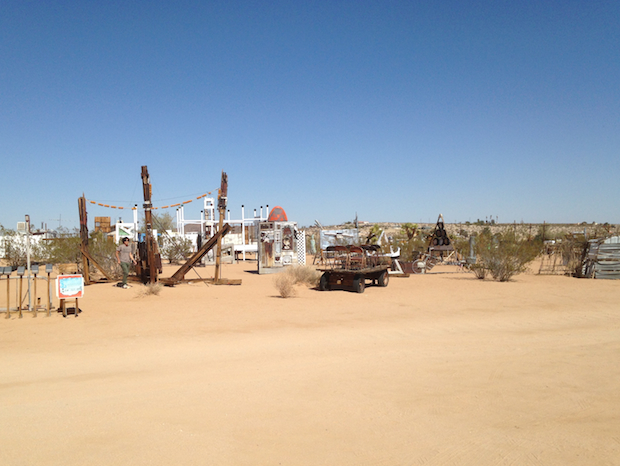


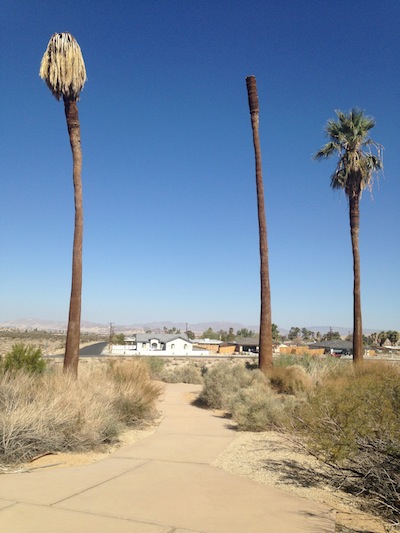
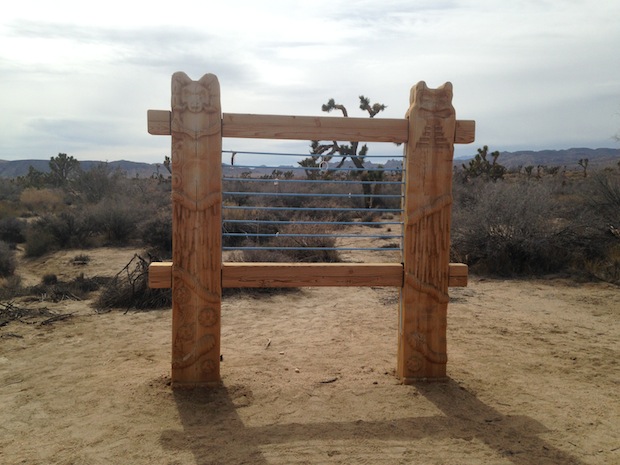
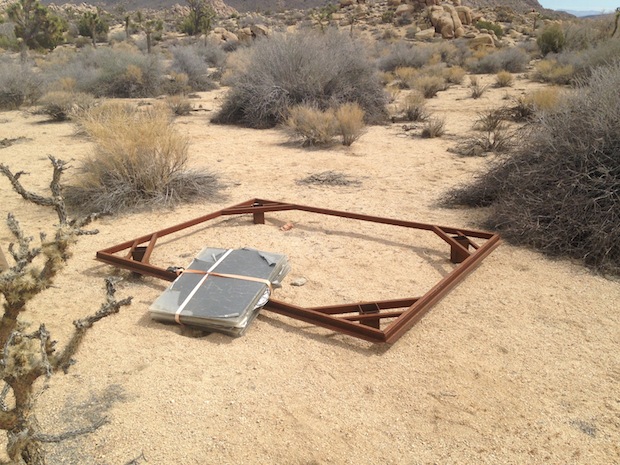
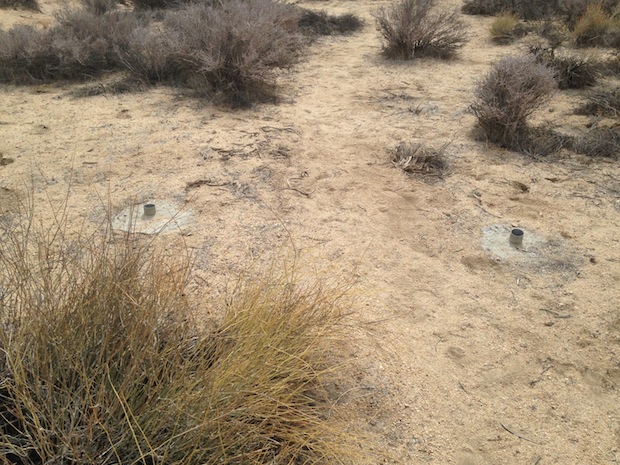

Comments on this entry are closed.